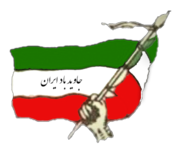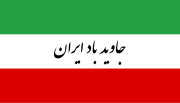Iran Party
Iran Party حزب ایران | |
|---|---|
 | |
| Secretary-General | Bagher Ghadiri-Asl |
| Founded | October 1941[1] as the Engineers’ Association May 1944[2] |
| Merger of | Motherland Party |
| Headquarters | Tehran |
| Ideology | |
| Political position | Centre-left[3] |
| National affiliation |
|
| Slogan | |
| Party flag | |
 | |
| Website | |
| hezbeiran | |
The Iran Party (Persian: حزب ایران, romanized: Ḥezb-e Irān) is a socialist and nationalist party in Iran. Founded in 1941, it is described as the "backbone of the National Front", the leading umbrella organization of Iranian nationalists established in 1949.[4] The party's total membership has never exceeded the several hundred figure.[5][6][7]
History
[edit]The Iran Party's core members derived from the Iranian Engineers’ Association (Persian: کانون مهندسین ایران, romanized: Kānun-e mohandesin-e Irān).[2] In the 1944 Iranian legislative election, five of the party's leaders, including Rezazadeh Shafaq, Ghulam'Ali Farivar, AhdulHamid Zanganeh, Hussein Mu'aven, and Abdallah Mu'azemi, won seats, as well as Mohammad Mossadegh (who was not a member but whom the party effectively supported).[8]
From June 1946[9] to January 1947,[2] it was allied with the communist Tudeh Party and some other left-wing parties under the name United Front of Progressive Parties. Following the alliance, some members left the party in protest and established the Iran Unity Party.[2] The party was part of the short-lived coalition government of Ahmad Qavam in 1946.[2]
In January 1947, the party expressed support for the Eisenhower Doctrine in a statement.[2]
The party helped Mossadegh establish the National Front, nationalize the oil industry and rise to power. Some members held office during Mosaddegh government.[2] It was suppressed following the British–American-backed coup d'état in 1953[2] and was outlawed in 1957, on the grounds that it had an alliance with the Tudeh Party of Iran ten years earlier.[10] It was revived in 1960 and actively contributed to the National Front (II), which was disintegrated in 1963 and forced to survive secretly. Iran Party held a congress in 1964.[2] Not much is known about the activities of the party between 1964 and the mid-1970s except of some irregular meetings and exchanging of views.[2] In 1977, alongside League of Socialists and Nation Party, it revived the National Front (IV) and demanded Ruhollah Khomeini's return to Iran.[2] In early 1979, then-secretary-general of the party Shapour Bakhtiar was appointed as the last prime minister by the Shah and included two Iran Party members in his cabinet.[2] The party, however, denounced his acceptance of the post, expelled him and called him a "traitor".[11] The party did not play an important role in Iranian political arena after 1979 and was soon declared banned.[2]
Secretaries-general
[edit]| Name | Tenure | Ref |
|---|---|---|
| Allahyar Saleh | 1944–Unknown | [2] |
| Abolfazl Qassemi | Unknown | [2] |
| Asghar Gitibin | Unknown | [2] |
| Karim Sanjabi | Unknown | [2] |
| Shapour Bakhtiar | 1978–1979 | [2] |
| Abolfazl Qassemi | 1979–1993 | [12] |
| Nezameddin Movahed | 1999–2007 | |
| Aligholi Bayani | 2007–2009 | |
| Sayed Hassan Amin | 2009–2019 | |
| Bagher Ghadiri-Asl | Current |
Ideology
[edit]Founded by mostly of European-educated technocrats, it advocated "a diluted form of French socialism"[8] (i.e., it "modeled itself on" the moderate Socialist Party of France)[13] and promoted social democracy[14] and liberal nationalism.[15] The socialist tent of the party was more akin to that of the Fabian Society than to the scientific socialism of Karl Marx.[16] Its focus on liberal socialism and democratic socialism principles made it quite different from pure left-wing parties, and it did not show much involvement in labour rights discussions.[2] The party is secular[1] and believes Islam is "sacred a religion to mix with the bread-and-butter issues of daily politics."[17]
See also
[edit]- Splinter groups
- Movement of God-Worshipping Socialists (1943)
- Iran Unity Party (1946)
- Party of the Iranian People (1949)
References
[edit]- ^ a b Abrahamian, Ervand (1982). Iran Between Two Revolutions. Princeton University Press. pp. 188. ISBN 0-691-10134-5.
- ^ a b c d e f g h i j k l m n o p q r s t u Haddad Adel, Gholamali; Elmi, Mohammad Jafar; Taromi-Rad, Hassan (31 August 2012). "Iran Party". Political Parties: Selected Entries from Encyclopaedia of the World of Islam. EWI Press. pp. 141–151. ISBN 9781908433022.
- ^ Foran, John Francis (1988). Social Structure and Social Chan. University of California, Berkeley. p. 627.
Iran Party, a left-of-center noncommunist grouping of intellectuals, technocrats, professionals and students
- ^ Yarshater, Ehsan (ed.). "Chronology of Iranian History Part 3". Encyclopædia Iranica. Bibliotheca Persica Press. Retrieved August 1, 2016.
- ^ Khonsari, Mehrdad (1995). The National Movement of the Iranian Resistance 1979-1991: The role of a banned opposition movement in international politics (Ph.D. thesis). London School of Economics and Political Science. p. 80. Archived from the original on 2017-10-26. Retrieved 2017-10-25.
- ^ ""Interview with Bakhtiar, Shapour: Tape 02. The Iranian Oral History Project is a unique resource for the study of modern Iranian history"".
- ^ ""Interview with Sanjabi, Karim: Tape 02. The Iranian Oral History Project is a unique resource for the study of modern Iranian history"".
- ^ a b Abrahamian, Ervand (1982). Iran Between Two Revolutions. Princeton University Press. pp. 190. ISBN 0-691-10134-5.
- ^ Abrahamian, Ervand (1982). Iran Between Two Revolutions. Princeton University Press. pp. 300. ISBN 0-691-10134-5.
- ^ Abrahamian, Ervand (1982). Iran Between Two Revolutions. Princeton University Press. pp. 419. ISBN 0-691-10134-5.
- ^ Seliktar, Ofira (2000). Failing the Crystal Ball Test: The Carter Administration and the Fundamentalist Revolution in Iran. Praeger. p. 114. ISBN 9780275968724.
- ^ William Branigin (17 June 1980). "Old Activists Hide Away in Mullah's Iran". The Washington Post. Retrieved 25 January 2017.
- ^ Abrahamian, Ervand (2013). The Coup: 1953, the CIA, and the roots of modern U.S.-Iranian relations. New York: New Press, The. p. 50. ISBN 978-1-59558-826-5.
- ^ Azimi, Fakhreddin (2008). Quest for Democracy in Iran: A Century of Struggle Against Authoritarian Rule. Harvard University Press. p. 127. ISBN 978-0674027787.
- ^ Gheissari, Ali; Nasr, Vali (2006), Democracy in Iran: History and the Quest for Liberty, Oxford University Press, p. 48
- ^ Siavoshi, Sussan (1990). Liberal nationalism in Iran: the failure of a movement. Westview Press. p. 71. ISBN 9780813374130.
- ^ Abrahamian, Ervand (1982). Iran Between Two Revolutions. Princeton University Press. pp. 277. ISBN 0-691-10134-5.
- 1941 establishments in Iran
- Banned political parties in Iran
- Democratic socialist parties in Asia
- Iranian nationalism
- Left-wing nationalist parties
- Liberal parties in Iran
- Liberal socialism
- Mohammad Mosaddegh
- National Front (Iran) affiliated parties
- Nationalist parties in Iran
- Political parties established in 1941
- Political parties in Pahlavi Iran (1941–1979)
- Secularism in Iran
- Social democratic parties in Iran
